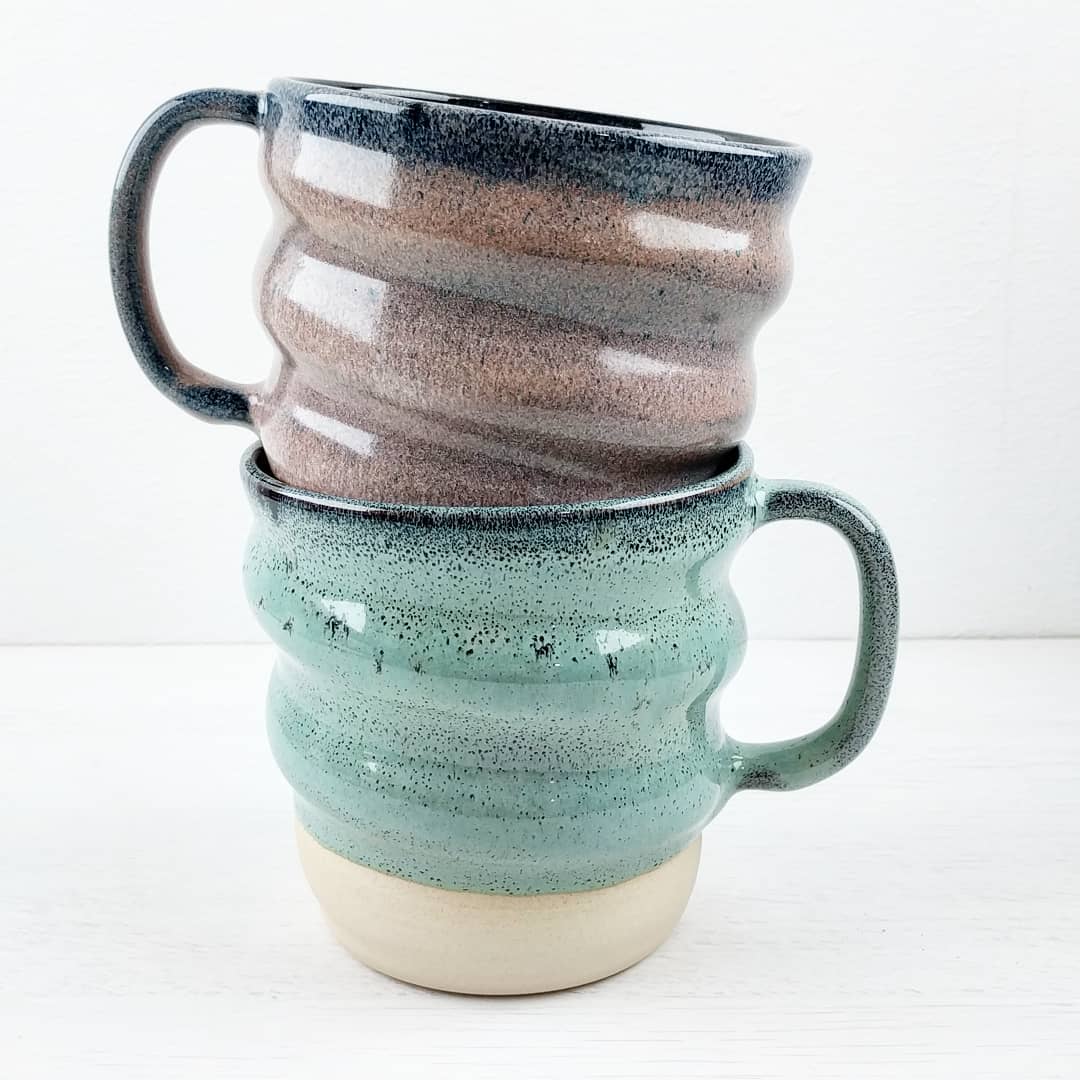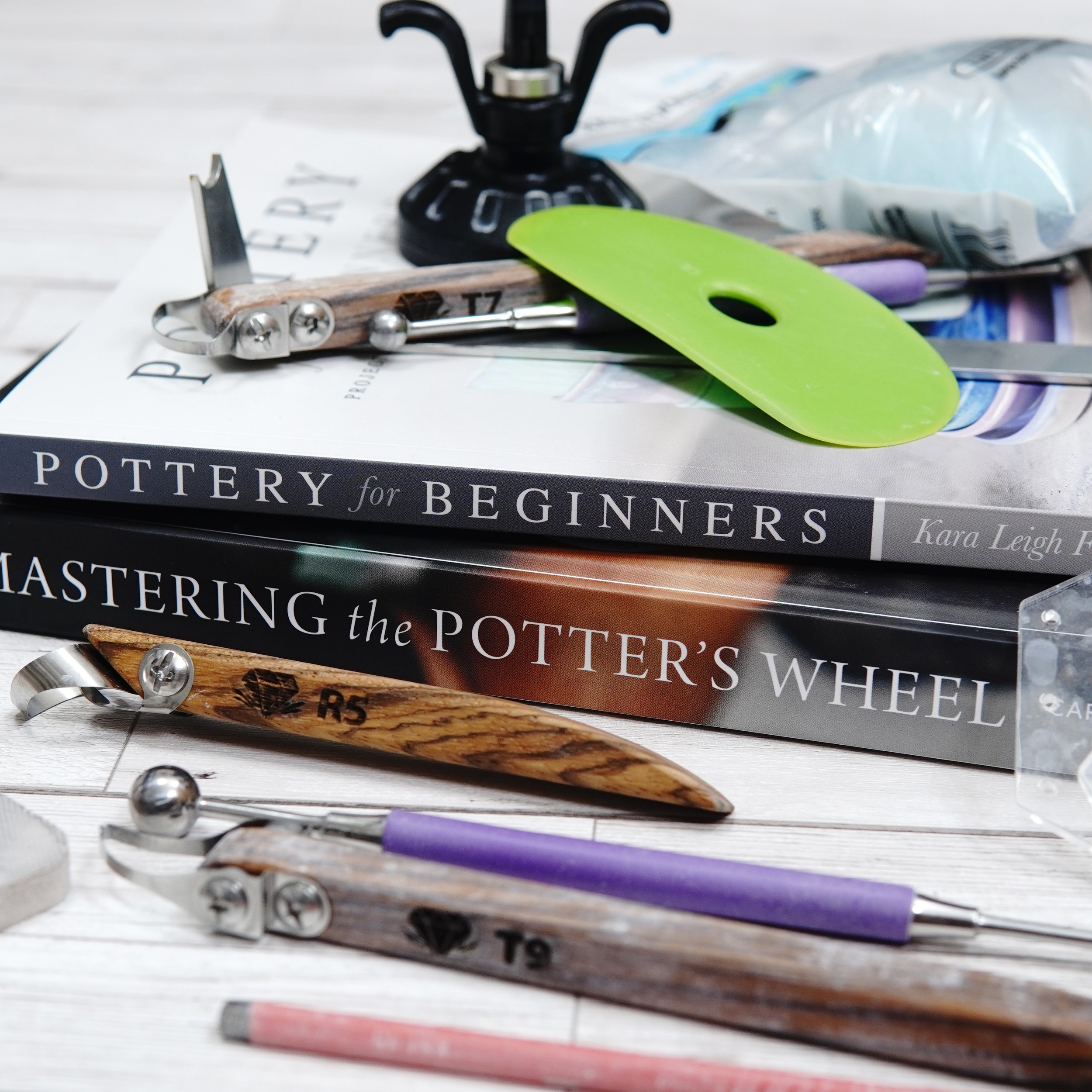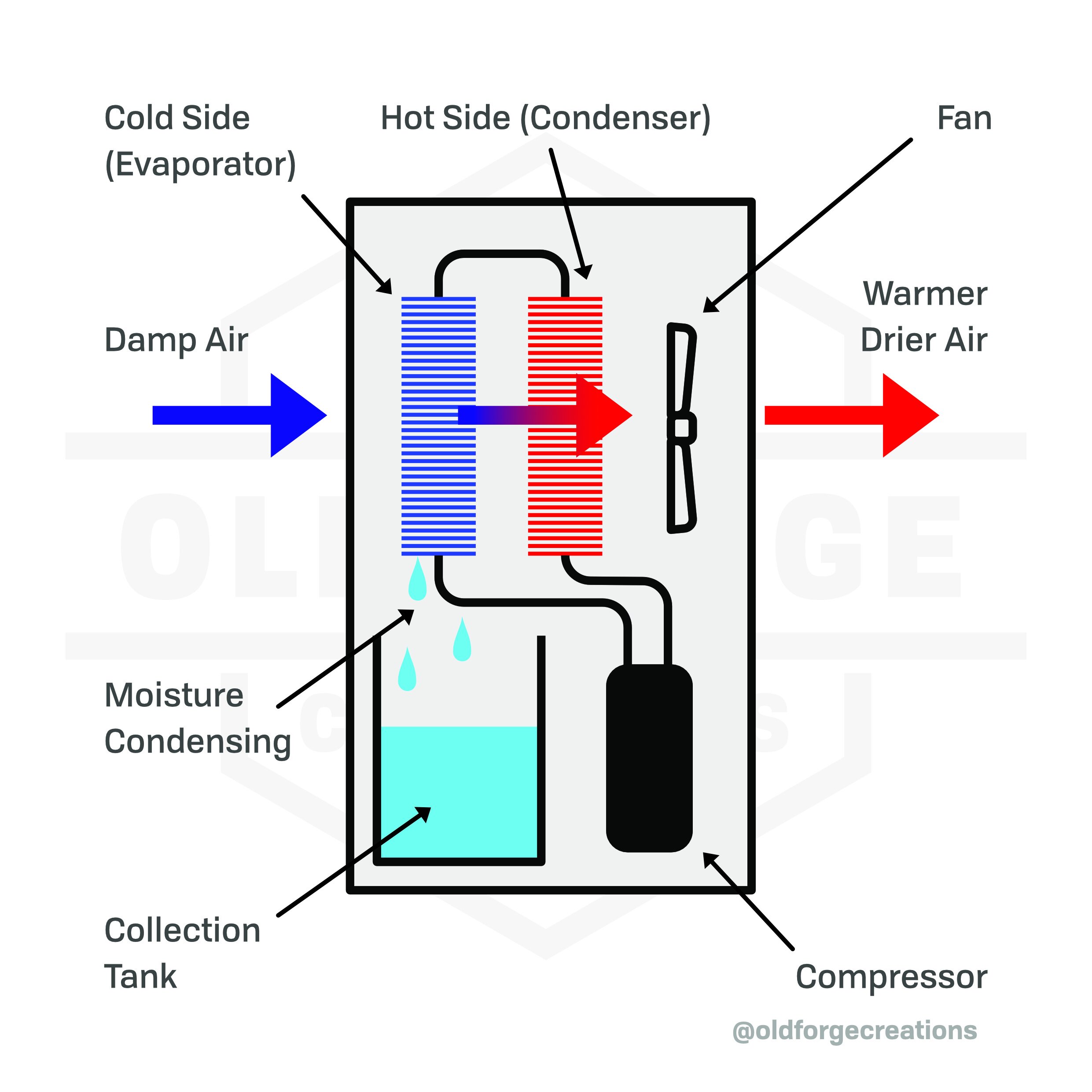What are Pugmills and should you get one?
Ever since I first learnt about wedging clay by hand, I wanted a pugmill. Unfortunately, they’re really expensive (more than a wheel and kiln combined) and very hard to justify in most situations.
Last year, I finally bought one.
What Is A Pugmill?
A Pugmill is a machine which processes and extrudes clay in a plastic (soft) form.
There are a variety of types and sizes of pugmill, with slightly different mechanisms, but the basic concept is pretty similar. Clay goes in one end, a screw thread mixes and kneads the clay, then compresses it to extrude it out the other end. They essentially replace wedging by hand (and don’t do much more than that).
‘Pug’ is a historic term for processing clay, which seems to come from the proto-germanic word ‘pugno’, meaning ‘to pound’ (but not everyone agrees on this!)
Pugmills can also de-air the clay, using a vacuum pump to suck all the air out during the processing. This adds an additional level of complexity and cost to the machines, but is potentially quite an improvement in the resulting clay. Bubbles of air within clay are a pain if you discover them when halfway through throwing a piece (it can often require scrapping the piece and starting over) and wedging by hand to fully remove air without accidentally adding more in is a skill too.
I’ve had my pugmill since late 2023 (Shimpo Deairing Stainless Steel - I paid around £6k for it). I intend to start making my own clay from scratch, at which point the pugmill will save me a ton of time, but so far I’ve used it regularly with bagged commercial clay and occasionally for processing reclaim (which will be the typical use of most studio pugmills). These are my thoughts and observations based on that experience.
Upsides
Physically Less Demanding
This is probably the number 1 selling point for most people. Working with clay is tough on the body, and wedging clay is one of the most physically demanding processes. It requires an amount of strength and joint health that can make it difficult or impossible for many potters. Even for the potters who are capable of wedging without issue now, there is the question of chronic injuries and general wear and tear when looked at over years/decades.
Easier
It is a skill to wedge clay effectively. Ideally you should move the clay in a way where any air bubbles are worked to the surface and no new bubbles are added, but this isn’t easy for new potters. A pugmill requires no such skill. Anyone can be shown how to use it and will be able to produce deaired fresh clay with equally minimal effort. This might not be such an upside for an experienced potter working alone, but if you have a shared studio, an apprentice or assistant, or just generally receive any outside help during busy periods, being able to hand off this task with no drop in the clay quality could be a huge benefit.
Faster
A pugmill can process clay fairly quickly (although this depends on the size/type/power of the pugmill). It’s not a hands-off process, as you will need to near constantly be adding clay to the hopper and removing the pugged clay from the outlet, but it will produce clay at a much faster rate than hand-wedged clay. You might still need to spend half the time per kilo of clay, depending on your pugmill and how quickly you can wedge clay, but that time saving will quickly add up if you’re dealing with larger quantities of clay.
Adjusting Consistency
Because the pugmill will do a pretty great job of breaking up and recombining clays, you can adjust the consistency of the final clay by adding firmer/softer clay as needed. If your clay regularly comes at a consistency that isn’t how you’d ideally like it, this ability to easily adjust the firmness is a huge benefit. This is even more pronounced if you’re buying a pugmill because of a physical issue with wedging, as you’re also likely to find it more comfortable if you can work with a softer clay.
Reclaim
We should all be reclaiming our waste clay scraps and throwing water (or at the very least, saving them up and giving/selling them to someone who will), but it is a lot of work. A pugmill won’t entirely solve the problem but will make it much easier to produce high quality reclaim from scraps without much physical effort.
I don’t have first-hand experience of this as I bought a continuous rather than reversible pugmill, but in theory a reversible mill can handle the rehydration and mixing of dry scraps. As I understand it, you put a watertight seal on the outlet, then pour your dry scraps and an appropriate amount of water into the pugmill while it’s set to reverse mixing. A continuous pugmill cannot do this stage, and the rehydration and mixing will have to be done separately (pour water into a scrap bucket, let it soak, (optionally, mix it up as a slip and pass through a sieve to remove unwanted debris) then dry to the right consistency on plaster slabs before adding to the pugmill)
Downsides
Price
They’re really expensive. There are basically no budget options for a pugmill and they can cost more than a wheel and kiln combined. They don’t often come up for sale second hand and are still expensive. At time of writing this, there are only two on eBay in the whole of the UK. In my experience they tend to be £1500-3000 (heavily used and without shipping) compared to £2500-4000 for a comparable new pugmill, and I’ve never even seen a deairing pugmill come up for sale second hand. If looking at a new deairing pugmill, prices start from around £6000 and climb steeply.
Size
They’re fairly big and heavy. With the stand, mine has a footprint of approximately 1.4m x 0.5m. I can roll it under a bench when not in use (it’s on castors, so can roll easily on a smooth floor), so it is more compact than other large pieces of studio equipment, but it still takes up an area of the studio floor. If you have uneven bumpy floors, the small castors won’t be much help. It is also around 150kg and is awkwardly shaped, so picking it up is not really an option unless you’re training for World’s Strongest Man.
Functionality
They only have one function. They’re very good at preparing clay, but as far as pieces of studio equipment go they probably have the narrowest range of processes they can be used for (and it’s not even an essential one. A kiln has a narrow range of processes too, but they’re arguably the most important).
Cleaning
They take hours to clean. It’s easily an hour or two to take mine apart and clean it, and it makes a lot of mess. The process to dissemble mine is relatively straightforward, there are about a dozen bolts that need to be undone to separate the 4 main sections, but removing the sections when they’re full of clay is infinitely harder than it would be if they were clean. There’s a lot of digging sticky clay out first.
It would be easier if it was taken outside and could be hosed down, rather than dissembled and cleaned in a sink (the pieces that can be removed from the body) or wiped clean with a sponge (the body and auger threads). The larger pieces of casing will likely be larger than your sink (and they’re heavy too) so it’s not an easy cleaning process, but still more convenient than the body and auger. [Note: this is just my experience with my pugmill. Smaller and/or simpler pugmills should be easier, and I’ve been told that reversible pugmills can be run with water inside to remove a lot of the clay before disassembly]
Either way, it’s a lot of work. But it needs to be done when switching clays because:
Trapped Clay
There’s a lot of clay left inside that it can’t extrude. Mine holds around 9kg of clay when it’s ‘empty’. Most of this is in the main path through the extruder and will be pushed out as soon as more clay is added behind it. At least a few kilos of it are in places that won’t be immediately pushed through, and these can become dislodged and mixed into your clay later. If you switch clays without dismantling and cleaning, you could get pockets of contamination at any point.
I thought it might just be a case of running enough clay through to clean out the previous clay, but this has proved less realistic a solution than I hoped. Maybe this is less of an issue with other pugmill designs (the deairing setup adds a lot of places for clay to become trapped), but with my pugmill this means that switching clay is a lot of effort or there’s a lot of contamination.
Should You Buy One?
Obviously, it’s a tricky question to answer. For the majority of people, they’re not essential but will provide value. So the question really is whether they provide enough value to be worth the high cost, and that will depend on a few factors:
How Much Clay Do You Use?
The cost of the machine will essentially be divided across all the work it does for you. If you’re realistically going to use tons of clay a year, buying a pugmill might effectively be like paying someone pennies to wedge a kilo of clay for you. If you barely throw much clay at all, it might be like paying tens of pounds/dollars per kilo.
To put this in example numbers, we can imagine two different studios who will buy a £6000 pugmill and get 30 years consistent use out of it. That’s essentially £200 a year, ignoring any additional costs or the resale value at the end. The first hypothetical studio is a communal studio with dozens of members and beginner classes (so many failed pieces to be reclaimed), and could be putting several tons of clay through every month. If the £200 was spread over 20,000kg of clay (around 1.7 tons a month), it works out at £0.01 per kilo. The second hypothetical studio is a single potter in a small garden studio using tens of kilos a month. If the £200 was spread over 200kg of clay (around 17kg a month), it would be an additional cost of £1 per kilo (that’s just for the clay preparation, not the clay itself).
The cost of a pugmill becomes negligible when divided over a lot of clay and a long time period, but it’s still a significant cost consideration when used for less clay. In the example above, the clay could actually cost less than the pugmill usage (cheaper clays in the UK are around £0.6-0.7 per kilo). This isn’t exactly a sensible comparison (the pugmill cost is actually vs the labour time/effort/cost of wedging by hand, rather than being a material cost like clay) but puts into perspective just how expensive they are. In a small studio, a pugmill might cost more than all of the clay put through it over 30 years.
How Many Clays Do You Use?
As mentioned above, switching between clays might be less convenient than you expect. You either have to fully clean the pugmill between clays or risk contaminating the second clay with the remaining trapped pockets of the first clay. This might vary greatly between machines, I’ve only used mine so I can’t meaningfully compare, but it should definitely be a consideration if you use more than one clay.
I know some people put their clays though in a sequence from lightest to darkest. So they might go from a white clay, to a buff, to a red, to a dark/black clay. This way the contamination is less obvious and the issue might be acceptably minor. The pugmill would still need to be cleaned before going back to the white clay, but at least that’s only once per cycle of clays.
How Much Do You Mind Wedging By Hand?
This is several considerations at once. Does wedging cause you pain because of physical limitations/injury/etc? How much wedging do you need to do and will it cause long term injury? How good at wedging are you? How well prepared is your clay before wedging?
These factors will all greatly affect the value you’ll get out of a pugmill. If wedging clay is causing or irritating an injury, then a pugmill is a great way to remove that issue entirely. If you’re slow at wedging and/or find you often add air bubbles rather than removing them, a pugmill will greatly increase the speed and quality of your clay preparation.
On the other hand, if you only need to wedge a small amount of clay at a time and you’re perfectly comfortable and competent at it, the potential value of a pugmill is almost nothing to you. Similarly, if your clay is well prepared and needs minimal wedging when taken from the bag then the pugmill will provide much less value.
Do You Reclaim Clay?
Unfortunately, my pugmill (the continuous extrusion kind) doesn’t help much with the majority of processes involved in reclaiming clay scraps. I still need to slake, mix, and partially dry the reclaim before putting it into the pugmill for processing and deairing. A reversible pugmill could do all stages of this within the mixing chamber itself, but I can’t personally comment on how effective it is.
Even if it only helps with one stage of the reclaim process, a pugmill can still significantly reduce the effort required to turn clay scraps into a well prepared and ready to use clay body.
An additional benefit I’ve found is that it decreases the amount of clay scraps in the first place. I used to keep a bag full of the plastic clay (soft, throwable consistency) scraps, as well as containers of dry trimming and liquid slip. There are various processes (like handle extrusion) that produce messy offcuts of clay that are otherwise at the perfect consistency to throw. These need to be rewedged to get the air pockets back out, so I used to collect them until I had enough for it to be worth the effort of wedging them all in one go. With a pugmill, you can just add them immediately back into the hopper and they’ll be mixed up and deaired along with the rest of the clay. So I no longer need to collect these and process them together, and there is no penalty for being inefficient with clay when loading the clay extruder. I can load it in the easiest and quickest way, then all the leftovers can go straight back into the pugmill.
So, Who Should Buy One?
It makes sense to invest in a pugmill if at least some of the following conditions apply:
You process a lot of clay
You would prefer not to wedge by hand
You don’t use many different clay bodies
Your studio is big enough to accommodate it
You can afford it without sacrificing the purchase of a more versatile piece of equipment
You have a physical issue which makes wedging harder and/or means you want to adjust the consistency of your purchased clay to be easier to work
It wouldn’t make sense to purchase a pugmill if the following apply:
You don’t use much clay
You have no issue with wedging by hand
You use multiple clay bodies regularly
You have a small studio with no spare space
There are other important pieces of equipment you need to purchase first
You are happy with the typical consistency of the clay you buy
I definitely don’t think they’re an essential purchase, or even a sensible purchase, for most people. They’re a significant investment and they only make sense in a context where that investment can realistically be repaid.
Would I buy one, knowing what I know now?
If I could go back in time to just before I bought mine, would I still buy it? I think I would, but it’s a very close decision. The upsides are smaller than I expected and the downsides are more significant. It’s still definitely better to have one than not, but it’s very hard to justify the cost unless you take a long view. It should be worth the cost over my entire career, and hopefully it will extend the potential length of my career by reducing the physical labour required.
If you like this sort of content and want to support the creation of more, I now have a Patreon specifically for it or a page on my website if you just want to make a single donation.















